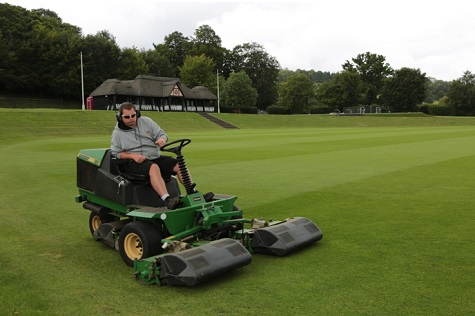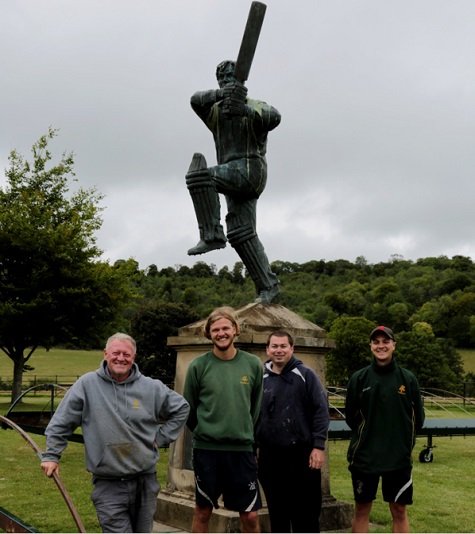Once the Covid-19 restrictions were eased, I finally had the opportunity to visit a sports facility and conduct an interview with the facilities manager / groundsman.
After much deliberation I decided it would be nice to revisit one of the country’s unique sporting venues, one I enjoyed visiting back in 2015. Set in rolling countryside outside Stokenchurch in Buckinghamshire, Wormsley is a private estate and has been home to the Getty Family since 1985.
Wormsley is also recognised for being the home of Garsington Opera, for its world-renowned Library & Cricket Ground, for its shoot and beautiful landscapes. More recently the estate has become known as a wonderful secluded location for meetings, functions, celebrations and weddings.

Ever since Sir Paul Getty was first introduced to cricket by Mick Jagger, a neighbour in Cheyne Walk, over cups of tea whilst watching Test Matches on the television in the 1960s, he fell in love with the quintessentially English game. When he acquired Wormsley in 1985, another great friend from the world of cricket – legendary commentator Brian Johnston – persuaded him to create a cricket ground on the Estate. Harry Brind OBE, the legendary groundsman at The Oval, was commissioned to lay the square and create a replica of the Test Match ground at Wormsley.
The result is often described as one of the most beautiful grounds in England – a justifiable description, not only for the beautiful setting but also for the quality and consistency of the wickets and outfield that cricket manager Simon Tremlin and his team have been producing for over 28 years.
The first game on the new ground was fittingly between two local villages that border the estate – Ibstone v Fingest on Sunday 10th May 1992. These village games continue to this day and form an important part of the history of the game at Wormsley.
The Wormsley ground was officially opened on Sunday 24th May 1992, by Bob Wyatt (England Captain – 40 caps) who rang the Wormsley Bell and Fred Trueman (67 England caps) who raised the Wormsley Flag. Sir Paul Getty XI played host to the MCC, watched by Her Majesty The Queen Mother and the then Prime Minister, Sir John Major.
To this day, the Sir Paul Getty XI continues to be a cornerstone of cricket at Wormsley with annual matches against various touring teams. However, this year the pandemic has played havoc with the planned fixtures and events planned.

Upon arrival at the gated estate I drove the last mile and half through the grounds to meet Simon at his prestigious cricket ground. I soon found myself at the famous thatched clubhouse, where I met up with three members of his grounds team, Andrew Wallis (11 years service) and James Reynoldson (8 years service) and part time worker Duncan Holt (3 years service) all of whom have either played cricket, coached cricket or had working experiences at other cricket venues. Another member of staff Simon Morse (25 years service) was on annual leave at the time of my visit.

Wormsley staff L-R: Simon Tremlin, James Reynoldson, Andrew Wallis , Duncan Holt
Simon was keen to explain how they have been coping during the pandemic. Essentially it put paid to half of the season’s fixtures with the first game played on the 26th July being a match between two local village club sides.
During the lockdown Simon and his team were able to get on with some refurbishment projects that included renovation, releveling and draining the croquet lawn, repainting all the roll on roll off cricket covers and numerous other bit and bobs while still keeping the general grounds and gardens maintained.
This first fixture between the two village teams was the first game on Simon’s newly constructed square. As mentioned earlier, the old square was laid under the directions of Harry Brind OBE, the then Oval head groundsman.
After many years of play and the fact that last year thousands of crows decided to ruin his outfield, he made the decision to kill two birds with one stone and rebuild the square and renovate the outfield. Last September he enlisted two well known cricket groundsmen to help relay the square, Keith Exton and Gordon Gill. Keith’s job was to bring in his Koro machine and take the top 25mm of vegetation off and leave a clean surface, while Gordon was brought in to lay down and consolidate the new loam materials.

In a little over two days Gordon was able to apply and laser level 240 tonnes of loam, 80 tonnes of Ongar plus loam to raise the middle of the square and 160 tonnes of Binders new 8% sand ameliorated binder Ongar loam mix.
A number of groundsmen are now starting to incorporate sand in their loams to help improve ball bounce and pace in their pitches. Simon has also chosen to install some reinforced fibres into four of his pitches enlisting the help of SIS Sport who have developed their popular SIS Grass systems which are now being used at many county grounds including Lord’s and the Oval.

SISGrass cricket pitches are made up of 95 percent natural grass and 5 per cent two-tone polyethylene yarn. with either a two green or straw-coloured yarn to make natural turf cricket wicket look as authentic as possible. And from a spectating distance, they are almost impossible to differentiate visually from a fully grass surface. The fibres are injected at 2cm x2cm at 20cm below the surface level, and up to 1 cm above the surface.
To date, the company have installed the SIS Grass in a number of national venues and they have been seen to be standing up to the rigours of cricket and have improved the performance and resilience of the pitches.
Once Gordon had finished his levelling Simon and his staff then began the final phases of the renovation in terms of overseeding and fertilising the square, plus covering over with germination sheets.
The whole square was overseeded with a MM29 grass seed mix a traditional renovation mix for cricket squares and outfields which contains excellent fine leaved ryegrasses, along with dense fescue and bent grasses.
Simon began his career at Wormsley some 28 years ago and was recently promoted to cricket manager, responsible for all the grounds, cricket facilities, tennis courts, croquet lawns as well organising all the cricketing events and fixtures.
However, it was all hands-on deck following the announcement that cricket could resume. Simon and his staff concentrated on preparation of the square and pitches for the start of the delayed cricket season. Their first high-profile match was on August 9rd when the Sir Paul Getty XI played against a MCC invitation team.

Over the years, Simon has built up a significant machinery portfolio to enable him to get the work done efficiently and undertake renovation works. His latest machinery acquisitions have been a GKB Seeder and scarifier.
He has also set up a contracting service which has grown substantially in the last five years, with over forty plus cricket clubs signed up for their end of season renovation works. It certainly keeps Simon and his staff busy and brings in some well-earned income to the estate.
And if that was not enough, he has now become the chairman of his local cricket club Aston Rowant CC and is now starting his second year in post.

As for aeration work, Simon will use a variety of aerators including a Verti-Drain, Toro Pedestrian ProCore and a Sisis outfield spiker. The chalk underlying the soil dictates his maximum depth of spiking (150mm), so more emphasis and time is devoted to spiking the top 100mm on a regular basis to help improve surface porosity.
With the ground set in the Chiltern Hills, it tends to have its own microclimate, resulting in cooler temperatures caused by wind chills, later frosts, and windier conditions. The strong winds play havoc with the raised covers and handling of the flat sheets. Simon has devised deep pegging systems to secure site screens, raised covers and the use of iron bars to weigh down the flat sheets. Like most groundsmen, he constantly keeps an eye on the weather radar to see what is predicted to be coming his way.
It was interesting to learn Simon's pitch preparation regime which, unlike the usual 10-13 day preps usually carried out by groundsmen, is somewhat different. In Simon's case, he leaves his grass length at 12mm, until three days before the game, using pedestrian paladin cylinder mowers.

These do a great job and help clear up any surface debris. Pitch prep starts twelve days out, beginning with a decent soaking of the pitch if required. He then rolls the next day, usually 3 x 30 minutes sessions with the two tonne roller. This is repeated the following day and thereafter, every other day with reduced rolling times (between 15-30 minutes).
Essentially, he likes to roll the grass into the surface. "If you roll grass into the surface, and get the soil and grass very dry, I find the ball skids through quicker, thereby helping to improve pace, which batsmen and bowlers want,” said Simon.
"I tend not to do any scarifying or cutting until three days before the match. I'll then reduce the height of cut using my faithful Lloyds Paladin, scarify using a pedestrian Sisis Combirake and keep the grass dry. I rely on a good surface density of grass, rather than be dictated by its length or colour."
With so many high-end corporate events being held at Wormsley, Simon is mindful that the whole estate should always look its best, so presentation skills come high on his agenda.
Simon’s wife, Charlotte also works on the Estate, in charge of all the gardens and production of flowers and vegetables, which are in constant demand throughout the year.

However, this year Charlotte has had to change the garden around considerably to accommodate the need to grow more vegetables for the residing family who themselves where in lockdown on the estate. No stranger to growing vegetables, Charlotte soon transformed the two-acre walled garden into an oasis of vegetables. They also have glass houses that again were used extensively for growing tomatoes, chillies, and other valuable food crops.

Charlotte and her three staff were kept extremely busy during the lockdown. Last year some parts of the walled garden were completely overhauled, removing a lot of old shrub bed plantings and replacing with new colourful perennial materials to increase the vibrancy and colour mix of the gardens.
Charlotte has also for the last eight years been sowing a lot of wildflowers mixes into the orchard areas to increase the vibrancy and biodiversity of these areas. The results have been spectacular. Her hard work and recognition for the work she does was recently rewarded with two excellent gardening reviews in The English Garden Magazine.

Simon, Charlotte and all the staff work in a unique environment, for a family who care passionately about their home and estate. Over the years, the Gettys have invested heavily into the estate and built up a loyal and dedicated workforce who deliver a high-class service for all the paying customers lucky enough to visit the Wormsley Estate.

I would like to take the opportunity to thank Simon and Charlotte for their time and for making me welcome at this unique cricket ground.